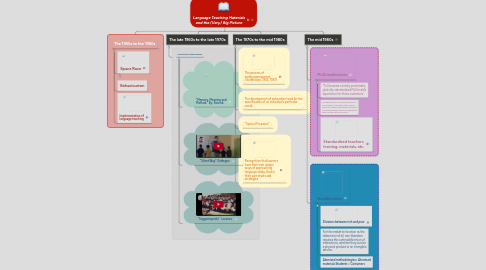
1. The 1950s to the 1960s
1.1. Space Race
1.1.1. Behaviourism
1.2. Behaviourism
1.3. Implementation of language teaching
2. The 1970s to the mid 1980s
2.1. The process of embourgeoisement (Goldthorpe, 1963, 1987)
2.2. The development of exhaustive tools for the specification of an individual’s particular needs
2.3. "Special Purposes"
2.4. Recognition that learners have their own unique ways of approaching language study, that is, their own styles and strategies.
3. The mid 1980s
3.1. McDonaldization
3.1.1. "To Generate a totally predictable, glob-ally standardised McDonald’s experience for those customers".
3.1.2. The phenomena of ‘McDonaldization’ is increasingly ‘colonising’ other areas of social life, where standardised products and standardised routines of interaction have now be-come the norm.
3.1.3. Standardized teachers training, materials, etc.
3.2. Neoliberalism
3.2.1. Divisions between rich and poor
3.2.2. For the market to function as the determiner of all, neo-liberalism requires the commodifica-tion of interactions, whether they involve a physical product or an intangible service.
3.2.3. Atomised methodologies= Atomised materials Students = Costumers
4. The late 1960s to the late 1970s
4.1. Humanistic Methodologies
4.1.1. “Memory, Meaning and Method," By: Stevick
4.1.2. "Silent Way" Gattegno
4.1.3. "Suggestopedia" Lozanov
